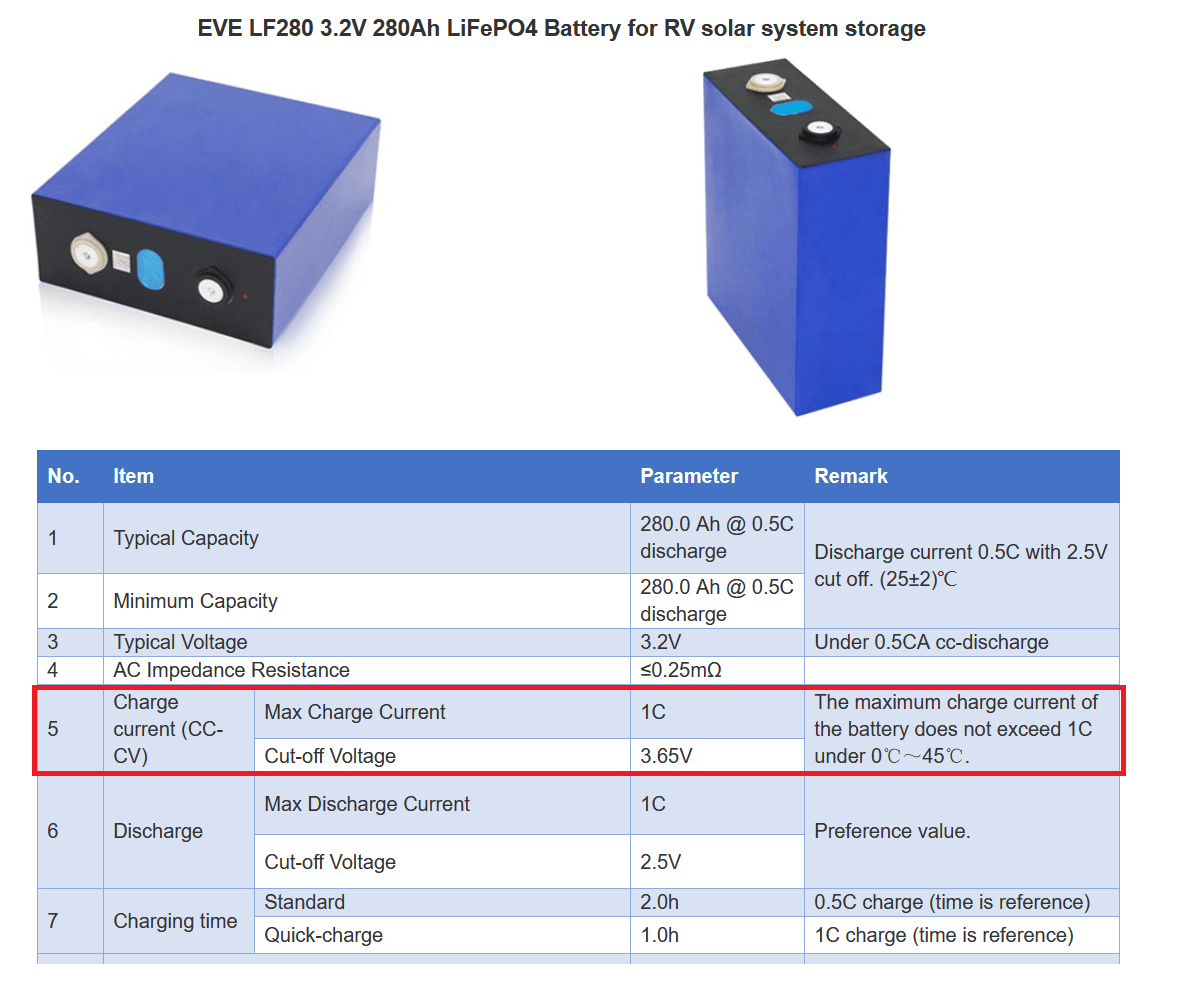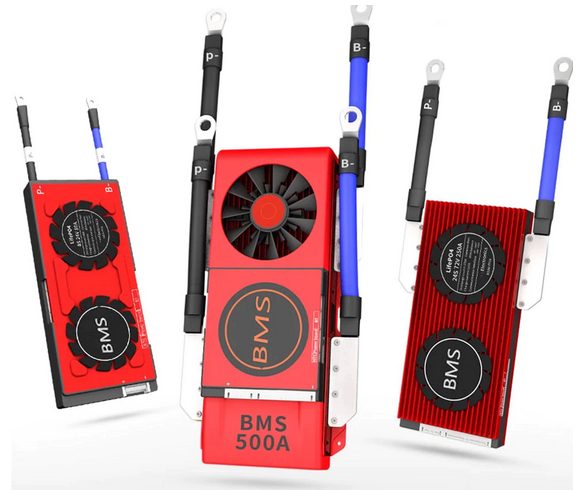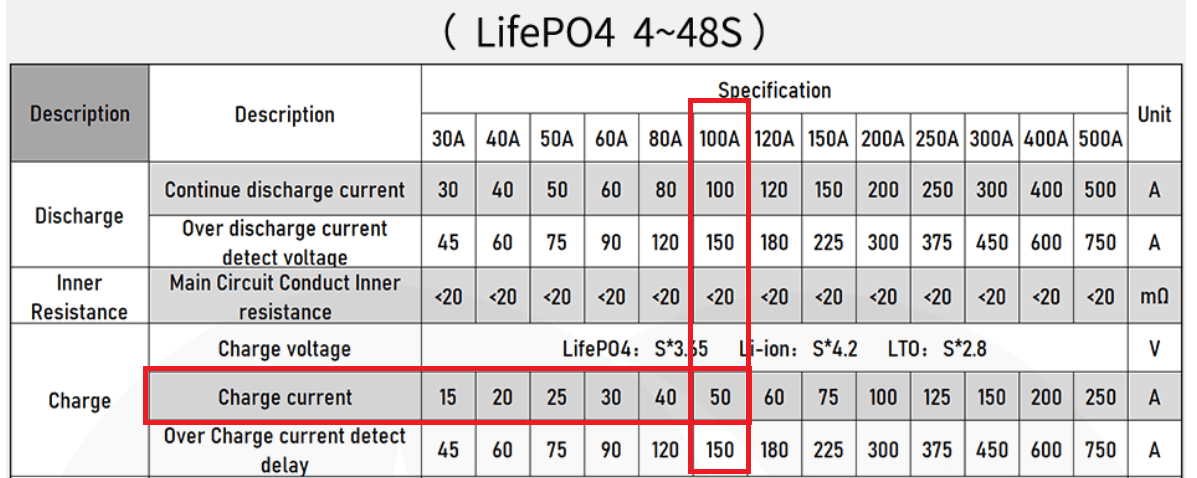Figuring out what current you should charge your LiFePO4 battery is easy.
There are two factors to consider:
- The recommended charge current of the cells
- The maximum allowable charge current from the BMS (battery management system)
Let’s explore the first.
Recommended charge current of the cells
If we take a standard 100Ah 3.2V EVE Lithium cell (we need 4 of these to make a 12V battery). We can see it has the following specifications:
- Typical Capacity: 100Ah
- Typical Voltage: 3.2V
- AC Impedance Resistance(1KHz): ≤0.5mΩ
- Standard Charge/discharge current: 0.5C/0.5C
- Operating Voltage: 2.5V~3.65V
- Maximum continuous charge/discharge current: 1C/1C
- Maximum pulse charge/discharge current(30s): 2C/2C

As we can see, the standard charge/discharge current is 0.5C.
Now, what is C?
C stands for C-rate. To know more about C-rate, I recommend watching my video about it.
The battery capacity (in Ah) multiplied by the C-rate gives you the recommended charging current.
In the case of a 12V 100Ah battery, the maximum charge rate is as follows:
100Ah * 0.5C = 50 Amps
If you have a 12V 200Ah battery, the maximum charge current is as follows:
200Ah * 0.5C = 100 Amps
Now if you have a 48V 100Ah battery (5kw server rack) the charge current is the following:
100Ah * 0.5C = 50 Amps
We can see that the maximum recommended charge current depends on the battery capacity (Ah), not the voltage.
If we use a larger battery cell, the 280Ah EVE cell for example, we can see that the recommended max charge current is 1C.

Let’s calculate the recommended charge current for this cell:
280Ah * 1C = 280Amps
We see that the c-rate is double. This is because the cell is much larger and can dissipate heat better.
The higher the cell’s capacity, the higher the charge current can be.
Maximum charge current of the BMS
Another limiting factor will be the charge rate of the BMS.
Each battery management system (BMS) has a maximum charging current. Take a popular Chinese BMS brand, for example.

If we take a 100A BMS, we can see in the datasheet that it can only charge at 50 amps.

If you have a 100amp charger, it won’t work. The BMS will shut down to protect the battery. This is because too much current gets sent to the battery cells.
Charging at a lower C-rate is not bad. It is better for the battery’s lifespan. Refer to my article about my recommended chargers for LiFePO4 batteries.
Conclusion
Figuring out at what amp you should charge your LiFePO4 battery is straightforward.
Multiply the C-rate of the battery by the capacity of the battery.
C-rate (usually 0.5) * Capacity (in Ah) = Recommended max charge current of a LiFePO4 battery.

I’m an off-grid enthusiast. I created this website to give clear and straight-to-the-point advice about solar power. I’m also the author of the book ‘Off-grid solar power simplified‘. Read more about me on my about page, check out my Youtube channel, or send me a message.

Newbie⚡Recently acquired a LFP12.8V400AH.
I would like to know what charging parameters to use before placing the battery in service.
I have an ADJUSTABLE CHARGER
DC Output: 0-15Vdc (Adj.)
DC Current 0-60A (Adj.)
My inclination is setting:
⚡DC Voltage: 14.6Vdc
I am Questioning BEST or OPTIMUM DC Current for initial charge rate? (Listing possibilities below)
50A for 8 hours
40A for 10 hours
20A for 20 hours
10A for 40 hours
other RECOMMENDED❓
Obviously, I must choose one method; If I am wrong about this, Please let me know.
The battery State Of Charge is about 15% in my estimation;
But I don’t know how to check the TRUE status except for the built-in digital meter that indicates 12.8Vdc and a battery symbol with 2 bars on the low side. Is there another way to check the actual SOC❓
Thank you for your answers or Recommendations on the above (?).
Charge at 14.6V and the maximum charging current is 200A depending on the BMS inside the battery. You need a shunt
What size charger should I buy to charge Lifepo4 12.8v 60ah battery? I would like the battery to charge to 14.6 volts. The charger I had was a 7 amp but I had it in a to confined area in the boat and charger stopped working. I’ve looked at 10 and 20amp chargers and confuised which to use. Hope you can help me Thanks
Depends on how fast you want it to charge. If your battery has a max charge rate of 1C, you can use a max of 60A. 12.8V*60Ah=768Wh. calculate charging time: 60Ah/10A=6 hours. 60Ah/20A=3 hours.
I have built a 48v 100ah lifepo4 battery with 16 cells.
I used my EG4 3000EHV inverter to charge it using 30amps.
According to the DALY Smart BMS 4S-16S 40A-500A the battery is 100% charged but shows capacity at 29.1ah.
It’s been several days and it won’t increase the capacity number.
Is it supposed to get close to 100ah or is this normal? Am I missing something in the BMS or inverter configuration?
I would not rely on the BMS for an accurate SOC. Instead i advise to install a shunt (aili or victron).